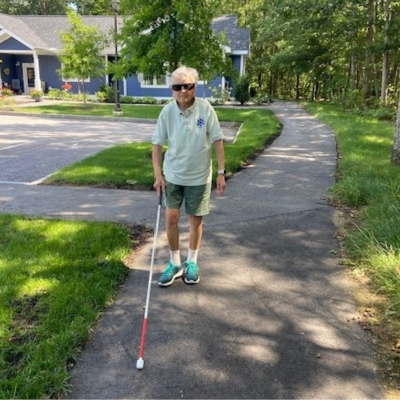
Have you ever been in a place that is totally dark? Picture a deep cave with no light. Maybe you’ve been in a fog so dense you can barely see a foot in front of you. How about stepping out of a dark movie theater on a bright summer day and you are blinded by the glare? Put yourself in any one of these situations and you’ll get a tiny taste of what it is to have a visual impairment or blindness. Now imagine you need to ask for directions – where is the bathroom or the exit? If someone says, “over there,” and casually points in the general direction, you’re more likely to get lost than find your destination.
Use specific directional language with people who are blind or visually impaired. Words such as left, right, or in front/behind are helpful to someone who can’t see the thing or location to which you are pointing. Saying, “the backpack is under the table on your right” provides better information. Using clock face directions can also be helpful. Put yourself in the shoes of the person you are assisting. Picture that person in the center of a clock. In front of the person is twelve o’clock and behind is six o’clock. Straight out from their right shoulder is three o’clock and nine o’clock from their left shoulder. This specific language can help a person find a location or item in a room or on a table. Clock face directions can also be used if a person cannot see what is on a dinner plate. In this case the plate is the clock and the food closest to the person is at six o’clock and farthest away at the top of the plate is twelve o’clock. You can say, “the chicken is at nine o’clock, carrots at six o’clock,” etc. When giving directions to someone in the community, be specific. For example, “from where you are standing, the restrooms are in the back of the store, in the right corner.” Or, “to get to the library turn left at this corner and it’s three buildings down on your right.” If you have time, offer to walk with the person. When offering to guide someone, always ask first and let the person tell you how you can be of assistance.
You may not know if someone has vision loss. The person might not use a cane nor have a dog guide. Some people with vision impairment may not fit your image of a person with vision loss. Make specific directional language a habit because it can help those who are sighted as well as those with VI.
Watch this video for some additional tips when interacting with someone who is blind or visually impaired. If you or someone you know is experiencing vision loss and could benefit from our services, please contact Future In Sight at [email protected] or 603-224-4039 today!
About the Author: Rhonda Haller is a Certified Orientation & Mobility Specialist at Future In Sight.

